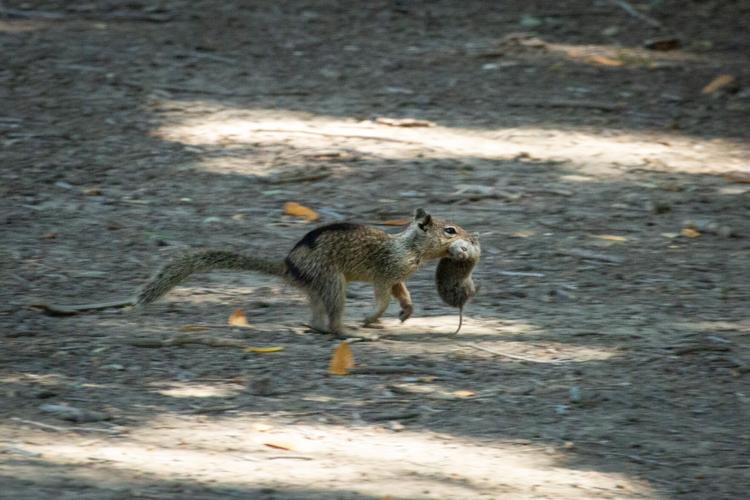Why California Squirrels Are Suddenly showing carnivorous behavior — Scientists Are Stunned
When most of us picture squirrels, we imagine the same thing: tiny, twitchy creatures hopping from branch to branch, cheeks stuffed with acorns, scampering through parks like harmless little foragers.
But that familiar image might be changing—and fast.
A startling new study has revealed that California squirrels are exhibiting carnivorous behavior for the first time in recorded history. Instead of just nibbling on nuts and seeds, these squirrels have been spotted hunting, killing, and eating other animals.
Yes, you read that right—squirrels are turning predator.

A Disturbing Shift in the Wild
For decades, squirrels have been labeled as “harmless omnivores,” their diets made up mostly of plant material, seeds, and the occasional insect. While there have been rare accounts of squirrels scavenging meat or eating bird eggs, active hunting was unheard of—until now.
Researchers observing ground squirrels in California noticed something unsettling: these animals weren’t just scavenging, they were actively stalking and killing small creatures like mice, birds, and even lizards.
Video footage from the study captured moments that shocked even seasoned wildlife biologists—squirrels pouncing with calculated precision, using teeth and claws to subdue prey.
“This isn’t accidental or opportunistic scavenging,” one researcher told the California Wildlife Journal. “These squirrels are hunting. That’s a profound behavioral change.”
Why Are Squirrels Becoming Carnivorous?
Scientists are still piecing together the puzzle, but several theories are emerging:
-
Climate Change: Droughts and rising temperatures have disrupted traditional food sources, making nuts, seeds, and berries harder to find.
-
Competition for Resources: Urban sprawl has shrunk habitats, forcing squirrels to adapt to new survival strategies—including predation.
-
Nutritional Needs: Some researchers suggest the shift might be driven by protein needs during certain seasons or breeding cycles.
In other words, this isn’t just quirky behavior—it could be evolution happening in real time.
What Does This Mean for the Ecosystem?
Anytime an animal changes its diet, the ripple effects spread through the food chain.

Squirrels—once considered benign gatherers—are now small‑scale predators. That could impact populations of songbirds, rodents, and reptiles.
“This might seem like a small behavioral tweak, but in ecological terms, it’s massive,” said Dr. Mariah Nguyen, an ecologist at Stanford. “When a species shifts its diet, it shifts the balance of an entire ecosystem.”
Already, bird watchers in some California regions have reported declines in ground‑nesting birds. And gardeners, once amused by squirrels stealing fruit, are now sharing uneasy accounts of “grisly” scenes in backyards.
Are All Squirrels Turning Carnivorous?
Here’s the good news: not all squirrels are suddenly becoming meat‑eaters.
The behavior has so far been recorded mostly among certain populations of California ground squirrels, not the fluffy‑tailed tree squirrels you see in every city park.
But scientists warn that once behaviors like this spread, they can travel quickly across populations.
“We’re not saying your local park squirrels are about to start hunting pigeons,” one researcher clarified. “But we are seeing adaptive changes that could alter how we think about these animals entirely.”
Humans Are Taking Notice
On social media, the news has sparked disbelief—and dark humor.
“First raccoons are washing their food, now squirrels are hunting. What’s next—chipmunk mafias?” one Twitter user joked.
Others are less amused, especially those who live in rural California. “It’s one thing when they steal my tomatoes,” a farmer wrote in a local Facebook group. “It’s another when I see one chasing a baby quail.”
A Reminder About Nature’s Flexibility
This discovery, as unsettling as it feels, is also a reminder: nature adapts.
Animals aren’t static. When their environments shift, so do their behaviors. The California squirrels’ move toward carnivory may feel shocking, but it’s also proof of how resourceful and resilient wildlife can be.
“Behavioral evolution isn’t something you just read about in textbooks,” Dr. Nguyen explained. “It’s happening around us all the time—and now we’re seeing it in creatures we thought we knew.”
Should You Be Worried?
Not really—at least, not in the “killer squirrel apocalypse” sense.
Squirrels aren’t suddenly a threat to humans, and experts emphasize that the behavior is still localized and mostly opportunistic.
But the study does underscore something important: we need to pay attention to how climate change, urban development, and habitat loss are forcing animals to rewrite their own rules for survival.
Because when squirrels change what they eat—it means the world around them is changing too.
Final Thought
The sight of a squirrel eating a mouse is undeniably jarring. It challenges the playful, nut‑hoarding image we’ve all carried since childhood.
But it also tells a deeper story—one about adaptation, resilience, and how even the smallest animals can surprise us when the world shifts around them.
Nature, it turns out, is never as simple as we imagine.